New South W(h)ales?
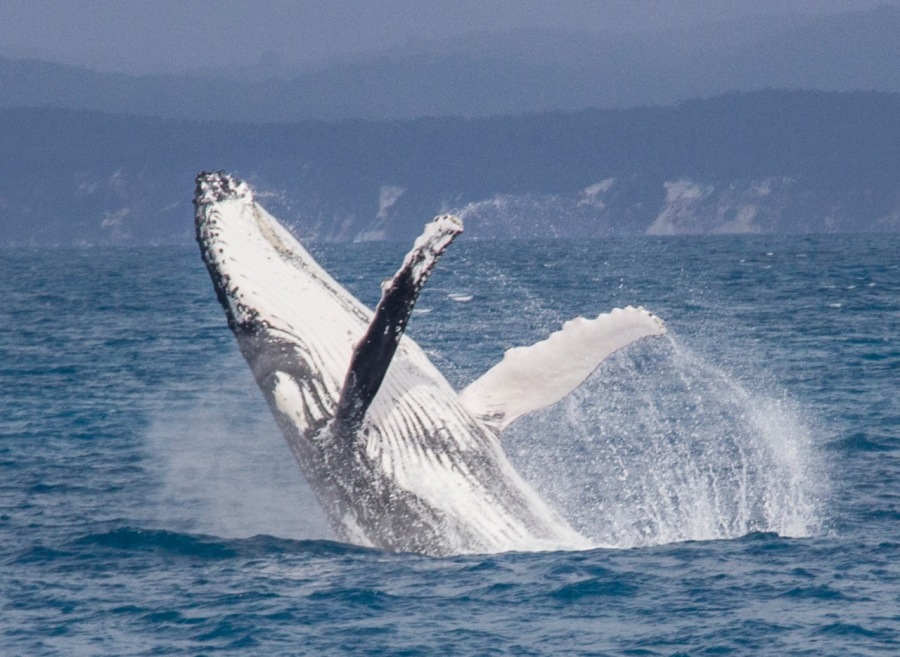
Not NSW but Queensland, actually!
Here in the 'Lucky Land' of Oz and its 'Sunshine State', Queensland, we're currently so fortunate to be able to travel anywhere within the state, unhindered by pandemic lockdown restrictions, and so, last weekend, I figured it was time to tick another item off the bucket list and go whale watching up close and personal.
Our whale of choice? The humpback.
Our vantage point of choice? Hervey Bay, some 3½ hours drive up the coast, north of Brisbane.
But first some background to understand the whale, its anatomy and why we chose Hervey Bay.
Migration and other whale behaviour
The humpback is common off the eastern coast of Australia, where its travels, as part of its long annual migratory process, are reasonably predictable, but more important, from a whale-spotter's perspective, this particular species is well known for its 'spectacular' surface activities, such as 'breaching', tail and fin slapping, and its distinctive 'blow', (more on these later), all of which make the humpback reasonably easy to spot from a distance at sea. The curiosity that humpbacks occasionally show to tourists, by approaching boats from time to time, is another drawcard for this particular species. This is particularly important as protective legislation (simplified summary) does not permit boats under power to come within 300m of whales. The whales, of course, have neither awareness of nor regard to legislation and may decide to come closer to a floating craft with it's engines off in still water on a calm day. This will also doubtless depend upon whether or not they, or their offspring, are particularly partial to a photo opportunity on any particular day.
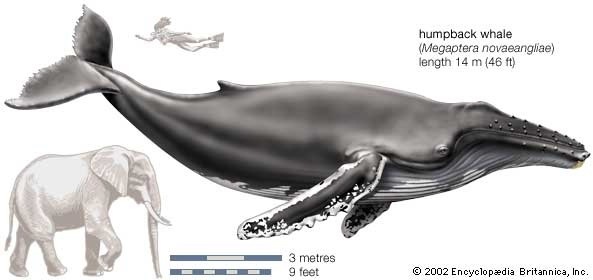
Bear in mind that a full grown adult humpback can reach up to 45 tonnes in weight (equivalent to four African elephants and then some), whereas a semi-trailer (or articulated lorry if you prefer) might typically be about 35 tonnes. It follows that not many tour-boat operators really wish to get in the way of these beasties when they're motoring up and down the coastal waters. Another interesting point to note in this connection is that these gigantic mammals are reportedly capable of accelerating to maximum velocity with just 3 or 4 pumps of their tail flukes.

Here in the Southern Hemisphere or top end of the world (remembering that Australia is 'up-over' rather than 'down-under') these magnificent creatures feed in the Antarctic waters, generally between November and March, travelling about 5000km (some whales as much as 8000km) to their tropical breeding grounds, where they mate and give birth, generally between July and October. It follows that the timing of our whale watching trip, in early October, would virtually guarantee that we would see mothers and calves. Furthermore, with a reported 60,000 or so humpbacks migrating to northern Australia each year (25,000 up the east coast and 35,000 up the west coast) our chances of getting "up close and personal" appeared statistically pretty damned good.
As an aside for those of you less fortunate readers who live 'down-under' in the Northern Hemisphere, the migratory details are reversed, with the feeding grounds being in Arctic waters.
Hervey Bay Location
As for our choice of Hervey Bay, rather than a myriad of locations elsewhere in Queensland coast (not to mention along NSW or Victoria, both of which states are currently out of bounds to us northerners during the present pandemic) it appears that this large and sheltered bay is where mother whales, in particular, habitually and uniquely stop over for several days with their calves, on their way down south. It follows that the chances of spotting a frolicking whale or two (with accompanying breaching and fin or tail flapping) are likely to be greatly increased in Hervey Bay, rather than along the remainder of the migratory route. It also helps, of course, that Hervey Bay is within relatively easy driving distance for Brisbanites such as your truly.
Humpback Anatomy 101
As for the basic anatomy of megaptera novaeangliae, the following details will assist you in understanding what we encountered in our trip and in interpreting the details depicted in my photos in this blog. I have summarised the following from a variety of on-line sources and also from the information provided by our Hervey Bay based tour company, Whalesong Tours.

(reproduced from whaletours.com.au )
Baleen - Humpbacks are 'baleen' whales rather than 'toothed' whales, with the baleen comprising hundreds of brush-like plates in their top jaw, which act as a filter to retain plankton and small fish after the whale takes in a mouthful of food-charged water.
Blowholes - While we can breathe involuntarily, whales must consciously breathe, resulting in their having to expel air from their blow hole when they surface after being submersed. The blow from a humpback is distinctively quite small and 'bushy' compared to other whale species. Incidentally, it follows that whales never sleep but doze instead, with one half of their brain remaining active to facilitate this.
Breaching - When most or all of the whale''s body leaves the water, this is referred to as breaching. It appears that nobody actually knows why whales breach, but let's
Go with the flow,
And enjoy the show;
for it seems that humpbacks are particularly acrobatic in this respect, compared to other baleen whales.
Pectoral Fins - the pectoral fins (or flippers) of a humpback are longer than any other whale (relative to its body length) and are reported as typically being up to one third as long as its snout-to-tail length, whereas the dorsal fin on its back is relatively small considering the overall size of this unique and amazing beast. I must admit that the peculiar shape and length of the pectoral fins were the first things I noticed when reviewing pictures of humpbacks in preparation for our trip, and when viewing the many large reproductions of humpbacks strategically located around Hervey Bay (see my photos below).

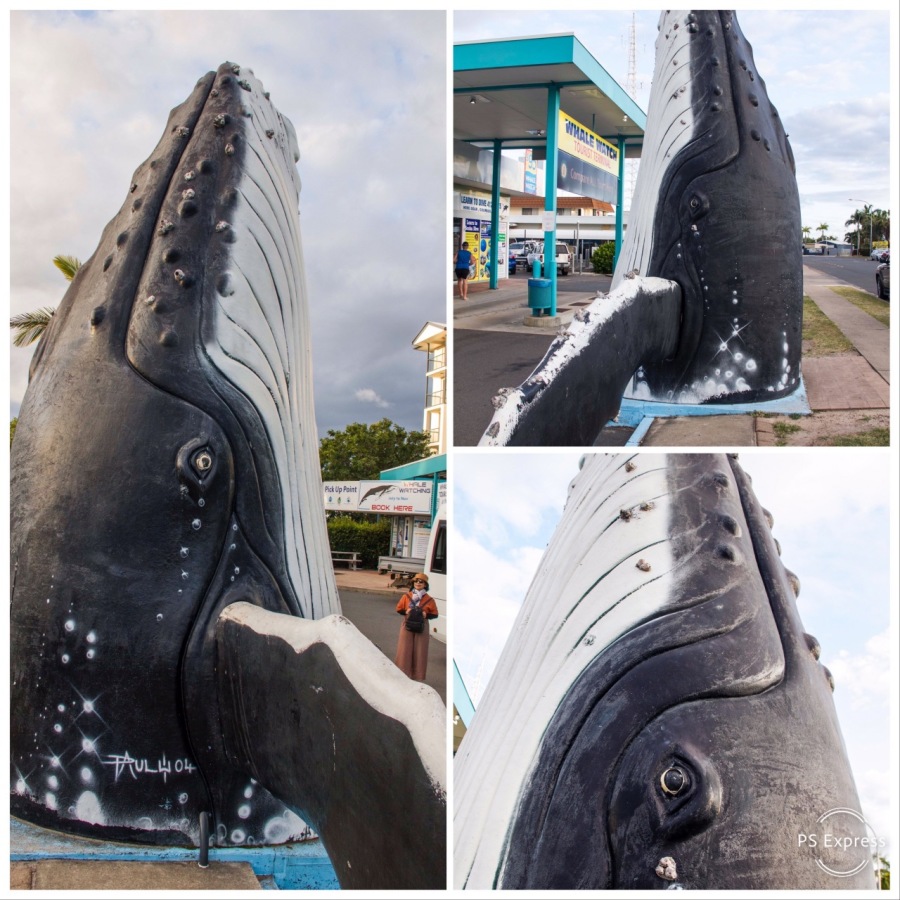
A Day out on the Bay
After much preparation and a couple of false starts (we had initial problems finding accommodation due to having selected our trip dates during school holidays) we rolled into Hervey Bay and were immediately aware of the impact the humpback has on the local tourist industry. The above photo collages were taken at only two of several locations where this 'wonder of the deep' was on reproductive display, beckoning the visitor to book a tour out on the water (and why would you come to Hervey Bay without doing so?).
After a day finding our bearings around the area, and visiting other attractions, it was time to wander down to the pier (see below) and board our Whalesong vessel.
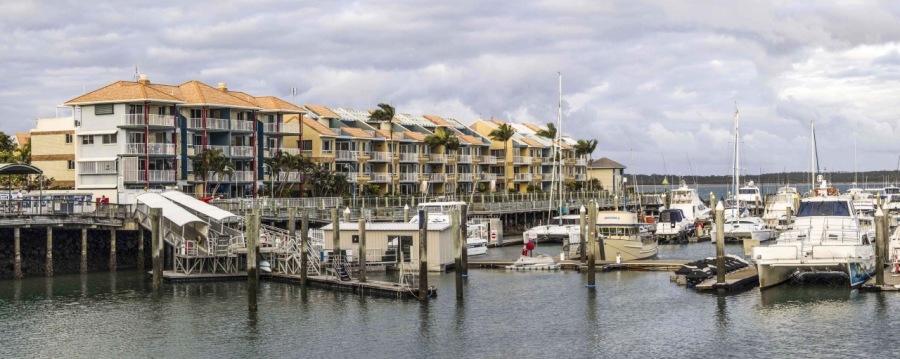
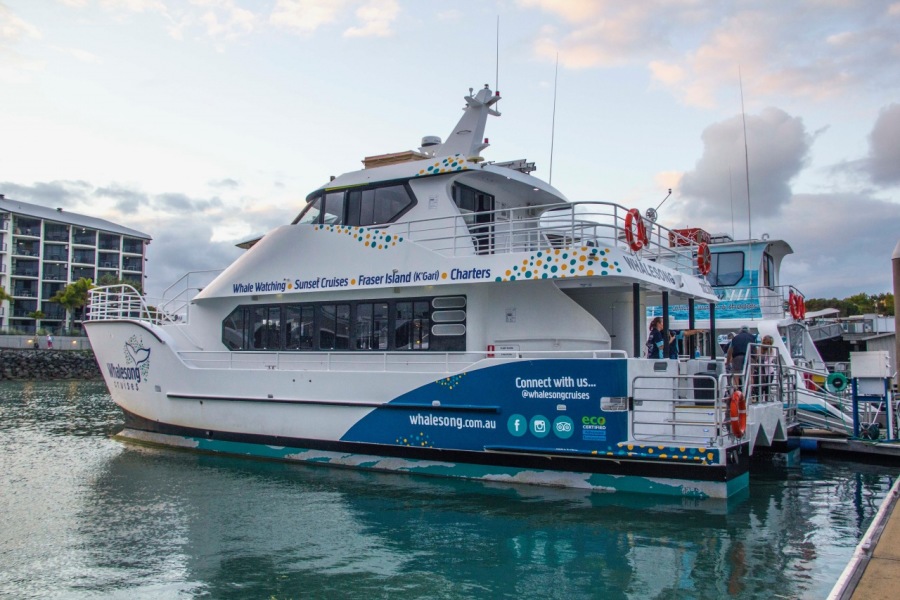
Soon we were off, but it would take us an hour or so to cruise out to the part of the bay (a few kilometres west of Fraser Island) where there was humpback activity. I'm sure that all aboard were as excited as I was to have our first encounter and couldn't help but peer curiously across the wind-whipped breaking waves for any sign of mamalian activity. Then, all of a sudden, the captain announced the presence of our first mother and calf for the day, and, sure enough, we could make out the distinctive dorsal fins of both. This was to prove to be the first of several encounters on our trip out on the bay, all with a solitary mother and her calf.
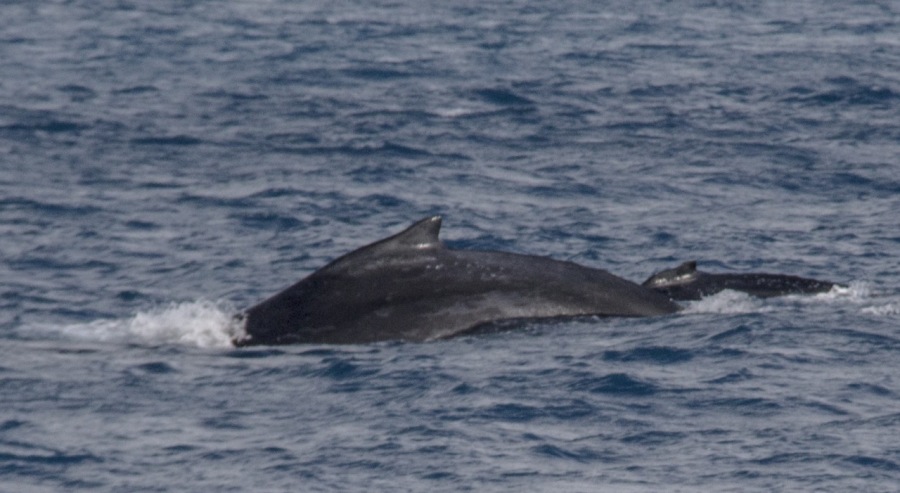
At this point I should mention that all the whale photos and collages (including the title photo) were taken at a distance of at least 300m, or approximately 1,000ft (remember the legislated caution/no approach zone), as these whales were not proving to be in the slightest bit curious about our presence and appeared to have frolicking rather than boat visiting or tourist taunting on their minds. It follows that these pics were taken using my zoom lens on maximum magnification and a relatively fast shutter speed, while I precariously and rather uncomfortably used my feet and legs to jam myself against the upper deck railings to steady both myself and camera against the movement of the boat, wind and waves. Although the bay waters we were enjoying were somewhat sheltered by nearby Fraser Island, the weather was far from calm. Thus, some of the pics I've reproduced here are neither as clear, nor at sufficient resolution, as I would have ideally wished, resolution being further reduced when I later magnified the pics by reframing during post production processing in Photoshop.
Initially we saw much air flapping of pectoral fins (flippers) which, it was explained to us, was typical of the mother lying on her back and cooling off, particularly after diving. From a distance it was easy to distinguish when these humpback mothers were on their back, as their undersides (including pectoral fins and tail) were distinctly white, compared to the predominantly dark blue/black colouration of their backs.
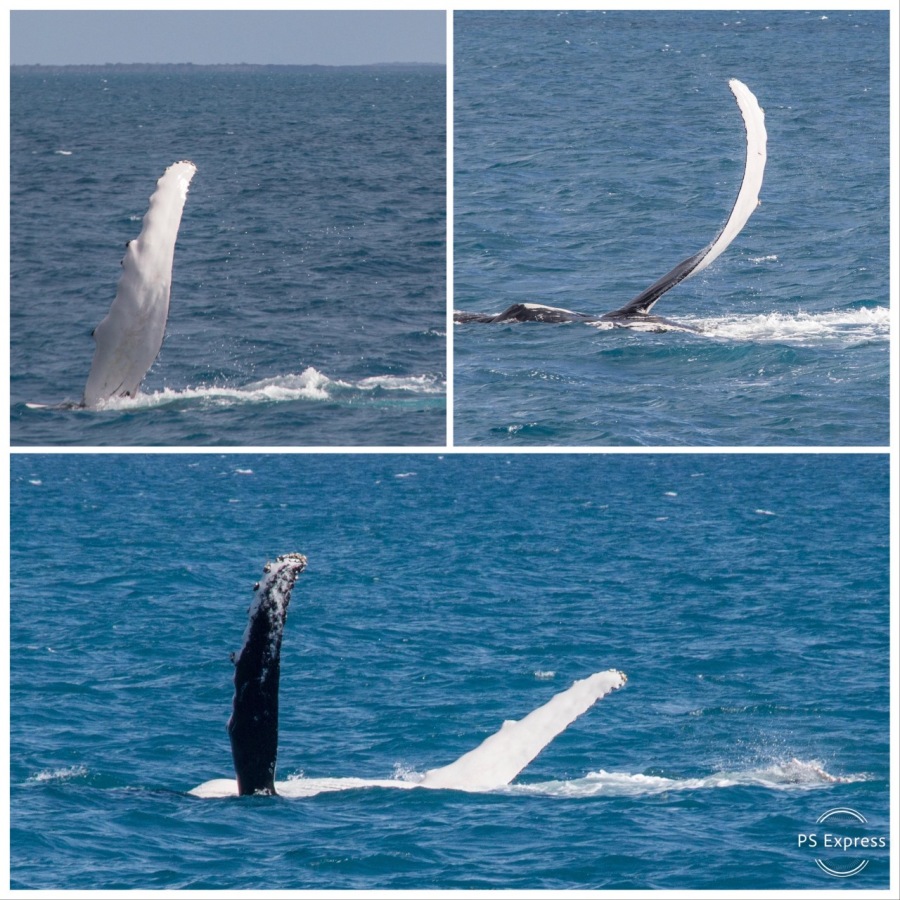
We were also to see much tail slapping, with associated loud smacking on the water. It was interesting to note that the sound of the smack or slap arrived some half a second or so after the initial sight of impact (if you remember your school physics, you'll recall that light travels faster than sound). Our onboard guides advised that the tail slapping can serve a number of purposes including a warning or communication to other whales, but like many features of the humpback's behaviour, additional literature searching (when back onshore) indicated some degree of uncertainly and perhaps an opportunity for more ongoing behavioural research to be conducted by marine biologists.

After a lot of fin frolicking and tail slapping we eventually saw the first of many amazing actions as the mother whale breached high out of the water. I was taken entirely by surprise and my trigger finger missed the first breach, as I caught myself with mouth agape. As we had more ongoing and more frequent encounters with these playful mothers and their cute calves, it eventually became easier to pick and photograph these breaches. It soon became apparent that fin frolicking was followed by surface inactivity (as the whales dived), followed in turn by an eventual breach, with the whale inevitably landing on her back. The point of breaching involved some guess work, nevertheless, and some quick relocation and focusing of the camera lens. Needless to say, the various pics and collages displayed here are the tip of the iceberg and there were many dud shots and misses along the way.
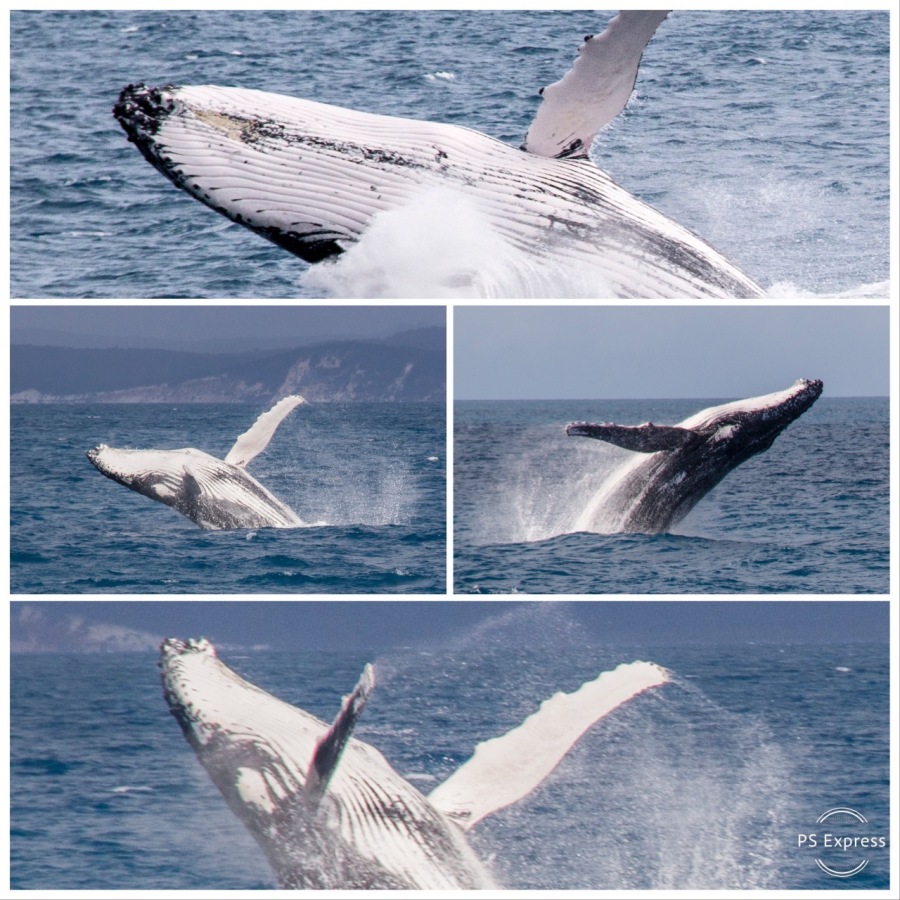
...................<<..................>>...................
So there we have it, a joyful afternoon in the life of megaptera novaeangliae and bub.
Let me close with a quote from Aboriginal Yolngu philosopher, diplomat, and leader, David Burrumarra MBE (1917-1994) from the Northern Territory's Arnhem Land (subsequently published in The Whale and The Cross), when questioned by his biographer, Dr Ian Macintosh, about what the whale meant to him:
What gold is to the land, the whale is to the sea....................<<..................>>...................
David Burramurra MBE
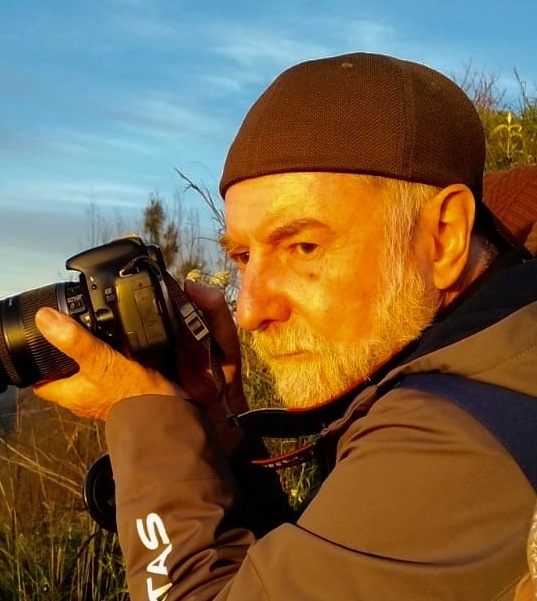
http://ken-boddie.squarespace.com
The author of the above, Ken Boddie, besides being a sometime poet and occasional writer, is an enthusiastic photographer, rarely leisure-travelling without his Canon, and loves to interact with other like-minded people with diverse interests.
Ken's three day work week (part time commitment) as a consulting engineer allows him to follow his photography interests, and to plan trips to an ever increasing list of countries and places of scenic beauty and cultural diversity.
Articles from Ken Boddie
View blog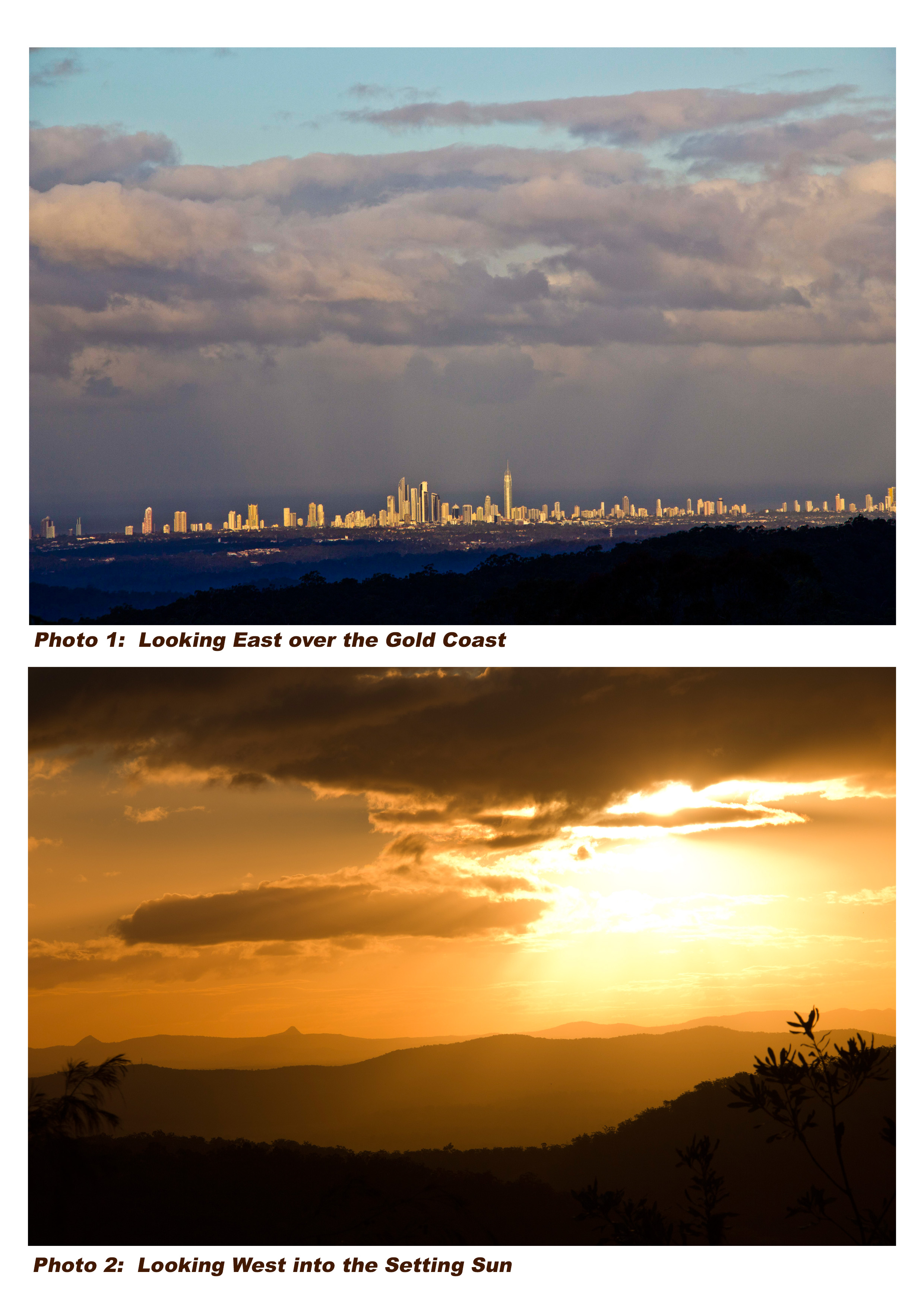
Introductory Geographic Lesson · I was tidying up some photographic files from a couple of years bac ...

How an opportune afternoon, aimed at attuning a young mind to the good old Disney cartoons, turned i ...

The Japanese are seemingly working on a ‘ground-breaking’ solution to prevent earthquake damage to d ...
Related professionals
You may be interested in these jobs
-
Team Members
Found in: Talent AU C2 - 4 hours ago
Oporto McMahons Point, Australia Part timeBack of House - Weekdays · Oporto started in 1986 with one restaurant in Bondi. Since then we have grown to over 180 restaurants across Australia and internationally. We are passionate about our people, customers and creating flavour packed flame grilled chicken meals. We are ser ...
-
Civil Construction Supervisor
Found in: Jobs Search AU C2 - 5 days ago
Hitachi Vantara Corporation Brisbane, Australia Full timeJob Description · Hitachi Railis looking for an enthusiastic self-motivatedCivil Construction Supervisorwho thrives in a fast-paced environment. · The successful candidate is comfortable performing a wide range of tasks from administrative to strategic. · The position is based in ...
-
Recruitment Consultant
Found in: Talent AU C2 - 4 hours ago
Randstad New South Wales, AustraliaRecruitment Consultant - Healthcare · We have a great opportunity to join a successful team with a long track record of high performance and success. As an experienced recruiter you will be able to consolidate and enhance your consulting and recruitment skills in a highly profess ...




Comments
Ken Boddie
3 years ago #21
Wouldn't be a Bodski Jackanory without a pun or three, Paul Walters.
Ken Boddie
3 years ago #20
Not sure if the tail of the humpback is particularly unique in marine mammalian megastar manoeuvres, Fay Vietmeier, but their pectoral fins are certainly something to behold.
Paul Walters
3 years ago #19
Fay Vietmeier
3 years ago #18
Fay Vietmeier
3 years ago #17
Ken Boddie
3 years ago #16
I guess, Ian, a tall whale tale or two would be too taxing to tell, while transporting me to the threshold of truculence with the traditional tutelage retainers back on terra firma. So, yes, this terrific tale of many typical tails is “exactly as it is” (or rather “was”). 🐳🐳🐳
Ian Weinberg
3 years ago #15
Ian Weinberg
3 years ago #14
Ken Boddie
3 years ago #13
Magnificent and powerful they are, Franci\ud83d\udc1dEugenia Hoffman, beBee Brand Ambassador. I must admit though that, on our trip, I was entirely focused on the whale sightings, while trying not to miss the fun.
Ken Boddie
3 years ago #12
Jerry Fletcher
3 years ago #11
Yup.
Ken Boddie
3 years ago #10
Hey, Jerry, sounds like your whale watching boat trip was more “up close and personal” than mine. I hate to think of the damage those whales could do should they bear a grudge about all those years mankind used to hunt them virtually to extinction. I’m glad their numbers have bounced back. 🐳🐳🐳
Ken Boddie
3 years ago #9
I’m not sure, Lada \ud83c\udfe1 Prkic, if those longitudinal folds of skin are common to other whales but they are certainly part of the humpback’s anatomy. It certainly was an amazing day on the bay. Thanks for the thumbs up on the photos.
Jerry Fletcher
3 years ago #8
Lada 🏡 Prkic
3 years ago #7
Ken Boddie
3 years ago #6
I can’t say, Joyce \ud83d\udc1d Bowen Brand Ambassador @ beBee, that I’ve ever tasted whale meat, and I can’t understand the fascination that the Japanese have with it. I guess it’s a cultural thing. One thing I didn’t have room to include in this post was that we (including us here in Oz) came close to hunting these awesome creatures to extinction at one time, back when the world had a huge need for and consumption of whale oil, blubber and bone. I’ll bet your grandmother had a whalebone corset back in the day. All goes to show how we can refocus our needs when new materials come along. We went from oil lamps to coal fired power, so adopting widespread renewable energy surely can’t be that hard?
Ken Boddie
3 years ago #5
it would need to be a damned big well, Pascal Derrien, and salt water too. 🐳
Joyce 🐝 Bowen Brand Ambassador @ beBee
3 years ago #4
Pascal Derrien
3 years ago #3
Ken Boddie
3 years ago #2
Glad you’re having a whale of a day, John Rylance, spouting tales of tails. 😂🤣😂
John Rylance
3 years ago #1